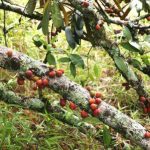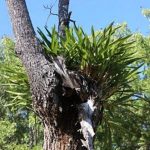TREE LIFE
December 1999
MASHONALAND CALENDAR
Sunday 6 December. Our Christmas social will again be at Bill Clark’s beautiful property Val D’Or in the Arcturus area. After tea which will be served at 9.30 we set off for another enjoyable session of Tree Bingo, in an area not yet Bingoed, with Phil Haxen in the lead.
Tea and coffee will be provided and as usual it would be nice if you can ring some Christmas fare to share. Bring your pen/pencil and your lunch and meet at Val D’Or at 9.30.
Tuesday 7 December. Botanic Garden Walk at 4.45 for 5 p.m. We will meet Tom in the car park and continue with the Euphorbiaceae family. There will be a guard for the cars.
Tuesday 4 January 2000. Botanic Garden Walk.
MATABELELAND CALENDAR.
Sunday 5 December. Jonathan will be showing us various Acacia species at Tshabalala. National Park fees are payable. Meet at Girls’ College for departure at 8.30 a.m. sharp
BOTANIC GARDEN WALK November 1999
Again, it was a small group just reaching double figures that assembled at the Botanic Garden for a continuation of Tom’s discussion of the large and very diverse family Euphorbiaceae. It is not easy to become reconciled with Euphorbia, Macaranga, Antidesma, Drypetes, Bridelia, Hymenocardia, Uapaca, and others as members of the same family. The only truly consistent character in this family is that the sexes are always in separate flowers. Leaves may be present or absent, but when they are present they are alternate.
The first species we examined was Antidesma membranaceum, a species that is usually more of a tree than Antidesma venosum. It is usually found on forest edges, as at Murahwa’s Hill, and the specimen we saw had not yet lost its old leaves. The leaves are discolourous, dark green above and yellowish below. We were overtaken by darkness before we found Antidesma venosum, but we did see the rare Antidesma vogelianum before the light failed. This latter species, with long slender branches, comes from the higher-altitude forests of the Chimanimani region. Its leaves are concolourous, shiny green on both sides, and thinly textured.
Another very rare species was Necepsia castaneifolia (formerly Neopalissya castaneifolia). This species is known only from the rain-facing edge of Chirinda Forest, where it is a shrub or small tree 2-3 m tall, with serrate leaves.
There was a bit of a digression as we examined Lasiodiscus usambarensis (Rhamnaceae), also confined to Chirinda Forest where it occurs as an understorey shrub or small tree. The specimen we saw was planted by Tom in 1982 as part of the ground cover in a dark part of the Botanic Garden. In spite of the lack of light, it was in full flower.
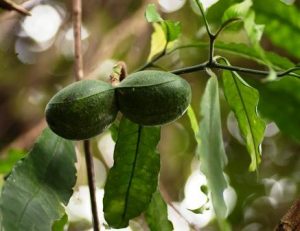
Tabernaemontana ventricosa. Photo: Bart Wursten. Source: Flora of Zimbabwe
Another digression, this time for a flowering specimen of Tabernaemontana ventricosa (Apocynaceae).
Macaranga capensis, a species of the lower altitudes of the Eastern Highlands, is easily distinguished from the higher-altitude Macaranga mellifera by its peltate leaves and its spiny branches. The spines often appear to be the beginnings of aerial roots.
Croton gratissimus was in flower, and it was interesting to see that the flower spikes contained both male and female flowers, the male occupying the terminal four-fifths of the spike, with only 2-3 females at the base of the spike. In this species flower buds appear in February at the height of the rains, but they remain closed until November. There was discussion about where Croton gratissimus occurs in Zimbabwe some members believing that it was present in the Kalahari¬ sand regions of the west of the country, but others not so sure. An examination of the distribution map in Coates Palgrave showed Croton gratissimus is, indeed, largely a species of western Zimbabwe, extending right across into Namibia.
The familiar Kudu-berry (which I have always known as duiker-berry), Pseudolachnostylis maprouneifolia, was seen in new leaf and flowers. The specimen we examined was just beginning to show signs of the characteristic cracking of the lower bark into squares, very similar to the tessellated bark of Eucalyptus tessellaris and some of its close relatives. As a matter on interest, the Shona and Ndebele names for this species, mudyamhembwe and upqhobampunzi respectively, are translated literally as “eaten by duiker” (not by Kudu!) Pseudolachnostylis maprouneifolia is probably best known for the vivid autumn and winter colours of its foliage.
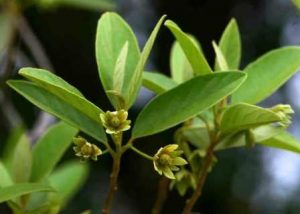
Kiggelaria africana. Photo: Bart Wursten. Source: Flora of Zimbabwe
Sophora velutina (Papilionoideae) created another digression when we came upon it in flower. This is a shrub known only from around the Zimbabwe Ruins and it used to be known as subsp. zimbabweensis, but the subspecific name seems to have been dropped. And there was a further digression to see Kiggelaria africana (Flacourtiaceae) in flower. This is a species of the Eastern Highlands forests, but it also occurs extensively in South Africa where the wood was formerly used for the spokes of wagon wheels.
The rather uncommon Alchornea hirtella was next on the list of Euphorbiaceae on our walk. It is a rainforest species of the Eastern Highlands, usually a small tree, with serrated leaves and lax branches that some¬times bear aerial roots. The more common Alchornea laxiflora from lowveld river fringes was not seen on this walk.
Finally, as dark was about to descend on us, we saw the very rare Drypetes reticulata, known in Zimbabwe only from the Nyoni Hills on the edge of the lowveld to the south of Masvingo. It also occurs in South Africa and Mozambique, but has only fairly recently been described and named. The leaf bases of this species are somewhat asymmetric, a feature shared by other members of the genus.
Our thanks go to Tom for a very interesting walk and for his discussion of a rather complex botanical family. Hopefully, we will continue with the Euphorbiaceae next month.
-Lyn Mullin.
Bee Crisis
The article in Tree Life No.236 October 1999 on the Matabeleland Branch outing of 4 July 1999, made reference to the lack of bees causing a pollination crisis. According to the article a disease is decimating our hives.
Happily, at the moment, honey bees in Zimbabwe seem to be relatively healthy and disease free. However, there are diseases and other problems which are currently facing beekeepers in South Africa which could spread to, and seriously threaten, Zimbabwe’s beekeeping industry, and the situation is being watched closely by beekeepers in this country.
One serious problem we do have with us right here and now, though, is the use of agricultural chemicals, and this may possibly be the reason for the apparent lack of bees at Mtshabezi Dam, not forgetting the severe drought suffered by Matabeleland which would also have contributed to this situation.
The Zimbabwe Beekeepers’ Council has recently formed an Apiculture Technical Committee (A.T.C.) under the chairmanship of the Department of Veterinary Services. This move being prompted by the threats to Zimbabwe’s beekeeping from neighbouring South Africa as mentioned above. But, apart from pests, diseases and crop chemical poisoning, the A.T.C. is also looking at Bee Botany in Zimbabwe, and possibly Tree Society members would like to participate in this latter aspect?
Bee botany work in this country has been minimal to date and mostly consists of lists of plants (mainly trees) attractive to bees. One notable exception was work done by Jerry Buckland when he was at Ewanrigg and it is that kind of detailed information he collected there that is needed for the rest of the country. Information required is as follows:
Plant species
Place or area of observation
Time of day
Whether bees were collecting pollen or nectar or both
Degree of bee activity – light, moderate, heavy
Alternative sources of bee forage close by
Prevailing weather conditions.
If anyone is interested in collaborating in this activity I would be most happy to hear from them.
Peter Taylor.
TREE SOCIETY (Matabeleland Branch) OUTING TO “HUNTSMAN INDIGENOUS TREES” 10 October 1999.
For our October outing Jonathan organized a visit to Huntsman Farm owned by the Williams family, where they also have an indigenous tree nursery.
The nursery and a trial plantation are situated just past Turk Mine, some 60km from Bulawayo, in a red clay area that has been greatly disturbed by mining activities over the last century. Some of the present dominant species are Dichrostachys cinerea, Acacia galpinii and Acacia nigrescens.
The Williams family warmly welcomed our party and tea was served at the homestead before we first proceeded to a trial plantation. This is the brainchild of Brian Williams who wanted to ascertain in a systematic manner the growth pattern of various indigenous trees. About 28 species of tree were planted in rectangular plots in 1992, the distance between successive rows of trees being progressively increased so that effects due to planting density could be determined. The species under observation include: Trichilia emetica, Khaya anthotheca, Acacia polyacantha, Acacia galpinii, Acacia xanthophloea, Kigelia africana, Berchemia discolor, Albizia versicolor, Albizia glaberrima, Afzelia quanzensis, Diospyros mespiliformis, Olea africana subsp. africana, Entandrophragma caudatum, Cordia abyssinica and Pterocarpus angolensis (Mukwa).
Initial observations that have come out of this study are:
a) In the early stages, close planting can generally be said to be beneficial to growth.
b) Space requirements of trees are variable both according to stage of growth and according to species.
c) Genetic differences in terms of adaptation to local conditions can be observed within groups of trees coming from the same seed stock. Although in the case of Khaya anthotheca, where seeds were obtained from a variety of sources, the superiority of any particular source has not been established. With Olea europaea subsp. africana specimens show large variations in leaf size.
An “edge effect” is very perceptible around the plot, but whether the extra growth is a result of extra root space or better access to light, or both, is not easy to see. A possible argument in favour of improved root space is the extra growth shown by some species in situations where improved light was not noted. Also noted in some instances was that adjacent lines of trees with different rooting depths thrive better than adjacent species with similar rooting strategies. It is likely that the impact of wildlife browsing in natural habitats was underestimated by early botanists. The slow growth rate attributed to some of our local species could well be partly attributed to browsing.
The plantation was severely affected by frost in 1994; it was interesting to see how self-healing occurs, and most species severely affected have now fully recovered. Selective pruning is now being applied to give the dominant individuals the extra space they require, and it is hoped that this will result in the selection of the strongest specimens for the production of improved seed.
A practical offshoot of this research could be the identification of varieties of indigenous species more tolerant of local conditions. A lot of the fence poles on the farm are, for instance, now made of Acacia species. For a long time, exotic gums and pines have benefited from international research, and it was easier and faster to use them rather than spend years on research to adapt our local species. The work being done by Brian and his family will certainly fill an important gap in our understanding and could be exciting news for the conservation of our indigenous flora.
As Jonathan remarked: “People do not expect children to be carbon copies of their parents, but expect every tree of a species to be identical to its neighbour”. Seeing many specimens in close proximity and at different growth stages certainly helps us appreciate the variability within a species.
From the plantation the party proceeded to the old stamp mill plant that Mr. Williams hires out to local gold miners at minimal cost to crush their ores. Local miners only retrieve the native gold from the crushed granite by panning. The residue is then further treated by cyanide process to recover the remaining gold.
After lunch on the beautifully tended lawns of the homestead, we went to look at the nursery. As some 174 different species of indigenous trees are on offer I will not list them here. Should anyone be interested the complete list is available from “Huntsman Indigenous Trees”, P 0 Box 20, Turk Mine (Tel. 185-306). Some of us could obviously not resist the temptation and came back with more trees for our gardens.
It was a most informative and enjoyable visit and taught me to use my Coates Palgrave with two pinches of salt instead of one.
-J.P. Felu.
MUCKING ABOUT WITH MANGROVES
Mozambique in October might have been unpleasantly hot, but we started off on a bitterly cold morning on 8 October and cleared the border at Machipanda shortly after 7 a.m. The road was superb for the first 150km or so, and the temptation to put one’s foot down and go was very strong. But you have to be careful of over-enthusiastic traffic cops in Mozambique! They now legally retain 75% of the traffic fines for their own personal use, and the Mozambique government gets the other 25%. A strange-sounding system to us, but a very effective one by all accounts for we were told that the government’s 25% cut of present-day speeding fines amounts to far more than ever came into the official coffers before. The standard fine for exceeding a bakkie’s 80km/h speed limit is one million meticais – about ZW$3000 – and we met two people who had been caught for that amount, and heard of a third. No matter what the temptation might be, it is better to stick to the speed limits!
Anne and I were on holiday with our family, as passengers on the back seat of a twin cab, so there was ample opportunity to look at the trees going down and coming back. The first thing that strikes you is that most of them had been hacked down, with very low mature-sized specimens left near the main road. It would appear that the demand for firewood and charcoal is the major reason for the disappearance of the trees, and to judge by the very evident poverty of most of the population things are not going to get better anytime soon. I had with me as a reference the van Wyk & van Wyk Field Guide (vW2), which is quite handy to carry around, but there was no real need to dive into it before we had reached our destination, Rio Savane, about 30km up the coast from Beira. The only real surprises along the main road were to find Brachystegia boehmii (Mufuti) well outside the limits shown in the distribution maps in vW2 and Coates Palgrave (CP). There are good specimens near the road around Chimoio, and I noted that it was still present as scattered specimens 57km on the Beira side of Chimoio. The distribution maps show it as present in Mozambique just outside Zimbabwe’s extreme north-eastern border, but this means that no herbarium specimens have been collected from central Mozambique. The other surprise was to find Brachystegia spiciformis (Msasa) within 3km of the coast, about halfway between Beira and Rio Savane. One mature specimen and several saplings were growing on what was essentially a high point – a “mound” – perhaps half a metre or so higher than the surrounding flat land, that is effectively an extension of the Pungwe Flats. The Msasa saplings – perhaps root suckers from the mature tree – were still in spring flush on our return journey on 23 October.
Other species noted along the main road were Parinari curatellifolia (Mobola plum) well outside its mapped range, Lonchocarpus capassa (rain tree) a bit outside its mapped range, Acacia xanthophloea (fever tree), Acacia karroo (sweet thorn) and Acacia sieberiana (paperbark acacia) both outside their mapped ranges, and Pericopsis angolensis (Muwanga), which is clearly a favourite charcoal tree in Mozambique – they call it chiwanga here. Only one specimen of Khaya anthotheca (red mahogany) was seen, and it appeared to be all that was left of a patch of forest between Chimoio and Gondola. In the Chimoio – Gondola region a great deal of pine and eucalypt plantation development has taken place – the eucalypt was practically all Eucalyptus grandis, but several Pinus species were noted, including Pinus patula, (hopelessly out of its environmental niche), Pinus elliottii, and apparently Pinus kesiya and Pinus oocarpa. There were plenty of neglected (and some obviously still-managed) citrus orchards, and, further towards the coast, large orchards of the biggest mango trees (Mangifera indica) I have ever seen. Towards the coast, also, plantations or avenues of cashew nuts (Anacardium occidentale) become more and more common.
We finally arrived at our destination at about 3 p.m., unloaded our gear, and were shipped across the kilometre-wide (or more) estuary of the Savane. It took two boat loads to get us across to the camp, all of it done in a howling gale at high tide with water sloshing all over us and soaking us all to the bone. The camp at Rio Savane is built in a coconut plantation on the banks of the estuary just a short walk from the seashore, but the sea is bidden from view by low dunes. The coconuts (Cocos nucifera) obviously date back to Portuguese days, when casuarinas were also planted there. Some of these trees are obviously old, and as far as I can determine they are probably Casuarina glauca (swamp she-oak), possible Casuarina equisetifolia (coast she-oak).
The natural flora of the area is surprisingly rich and varied, although at first sight it didn’t seem so, but my main interest was the mangrove species along the estuary. Nine genera in seven botanical families contribute to the mangrove belts of southern Africa (see CP, p 652), and six genera in five families were identified at Rio Savane. These are Avicennia (Verbenaceae), Barringtonia (Lecythidaceae), Bruguiera and Rhizophora (Rhizophoraceae), Heritiera (Sterculiaceae), and Xylocarpus (Meliaceae). The last two do not appear in vW2, and I had to wait to consult CP on my return home, having made appropriate notes and collected a few mature fruits.
Avicennia marina (white mangrove) is by far the most common tree in the mangrove belt at Rio Savane, and is very easily keyed out in vW2, in spite of the absence of fruit or flowers, and in spite of what appears to be a stipular scar or ridge that Avicennia is not supposed to have. This species occurs on the Kenya coast. I did not actually find Barringtonia racemosa (powder-puff tree) in the mangrove belt, but I saw plenty of its dried fruits washed up on the beach. These are cone-shaped and have fibrous coats that give them buoyancy in the water. A more thorough search in the mangrove belt might have turned up a few specimens, but a metre-long black mamba had been shot in the camp the day after our arrival (and a larger one escaped) and I was not particularly looking for any close encounters of the lethal kind! This species also occurs at least as far north as the Kenya coast. Bruguiera gymnorrhiza (Black mangrove) and Rhizophora mucronata (red mangrove) are quite common and easily identifiable, and I was surprised to see that the distribution maps in vW2 and CP show the latter as only just creeping into the extreme south of Mozambique from the Natal coast. I’m sure it has at least the same range as Bruguiera gymnorrhiza, but obviously no herbarium material has been collected from further north. Both species were in fruit, and those of Rhizophora mucronata were the more common among those washed up on the beach. Both species occur on the coast of Kenya. I found only one specimen of Heritiera littoralis (Mozambique mangrove) and I could not key it out from vW2 because it is not in the book. However, there were a few mature fruits on the tree, which I collected, and the leaves are distinctly discolourous – grey-green above and silvery below – and the species was easy to track down in CP on my return home. The fruits have a distinctive keel, and there were hundreds washed up on the beach, so many that the species has to be common in the mangrove belt even though I found only the one specimen (? close encounters…!) This is another mangrove that is incompletely mapped; it is shown in CP as occurring along a relatively short stretch of the south-central Mozambique coast, well down from Beira, but it is also known from the coast of Kenya. The last of the mangroves that I was able to identify was Xylocarpus granatum (mangrove mahogany), but as it does not appear in vW2 it also had to wait until I got home. The fruit of this species is very distinctive – 15-20 cm in diameter and not quite a perfect sphere. There is an illustration of part of a fruit in Flora Zambesiaca Vol. 2, Pt 1, p 298. It must be unusual to have one of the family Meliaceae as a mangrove, but there it is. I had a lot of trouble trying to decide whether the leaves were really compound, they appeared to be so, but there did not seem to be any identifiable bud in the leaf axils. This species occurs at least as far north as the coast of Kenya.
It is just possible that Ceriops tagal (Indian mangrove) is present in the Rio Savane region. It does not appear in vW2 except for a note to say that it is very similar in appearance to Rhizophora mucronata, but the leaf apex is rounded and does not have the bristle-like tip. Certainly, there were a number dunes along the coast at Rio Savane are covered with a host of procumbent plants that have got a grip on the sand and have provided conditions now suitable for the establishment of small trees and shrubs. Most of them were unknown to me. Quite prominent among them was what looked suspiciously like a Mucuna species (buffalo bean), but it has a benignly hairless pod. Another appeared to be a species of Bauhinia after the style of Bauhinia fassoglensis. A species of Cleome was quite common as an almost procumbent herb, the genus easily recognizable by its leaves and flowers.
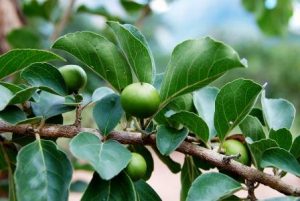
Flacourtia indica. Photo: Bart Wursten. Source: Flora of Zimbabwe
There were several specimens of Flacourtia indica (Batoka plum) with markedly rounded leaves, and of Clerodendrum glabrum (white cat’s whiskers) with thick, almost spongy (but paradoxically brittle) leaves, and without the usual fetid smell. Another plant was keyed out as Pterocelastrus tricuspidatus (candlewood), a new species to me; all characters agreed with the description in vW2, except that the petiole was not reddish, and Rio Savane is very far out of its mapped range. Garcinia livingstonei (African mangosteen) was not uncommon as a short and very contorted shrub; the species is familiar to me and I recognized it as once, but I was surprised to find it at Rio Savane. This region is outside its mapped range. Cleistochlamys kirkii (purple cluster-pear) keyed out perfectly from vW2; I have collected this species in the Zambezi Valley and it appeared familiar at first sight, but Rio Savane is outside its mapped range. A species of Indigofera is common among the ground flora of the dunes, and I saw many specimens of Sophora inhambanensis (coast bean bush), a markedly silvery leguminous shrub, up to 2 tall, with alternate leaves, 4-6 pairs of leaflets plus a terminal’ leaflet, and a very constricted pod, waisted between the seeds, rather like the pod of Erythrina lysistemon (lucky-bean tree), but silvery grey like the rest of the plant. It is not in vW2, but I was able to track it down in Elsa Pooley’s Trees of Natal Zululand & Transkei on my return home. Dodonaea angustifolia (sand olive) was present on the banks of the Rio Savane estuary, at high tide level but outside of the mangrove belt. This species occupies an astonishingly varied range of habitats, from saltwater estuaries, to our Eastern Highlands, to the central watershed, to the Eastern and Western Cape in South Africa. And I have seen it in Namibia, but this part of its range does not appear in currently published maps. A procumbent, some¬times scrambling, Grewia, with markedly rounded leaf spices, keyed out well to Grewia occidentalis in vW2, even to the 4-lobed, reddish-brown fruit, but there were no flowers for confirmation by their purple colour, and the leaf apex was much more rounded than normal – more like those illustrated for Grewia lasiocarpa in vW2, or for Grewia sulcata in CP. The colour of the flowers would be important in finally determining what this species really is. It falls within mapped range of the white-/yellow-flowered Grewia sulcata and is somewhat outside the mapped range of the mauve-flowered Grewia occidentalis. Finally, an interesting find on the edge of the mangroves was Hibiscus tiliaceus (coast hibiscus), a new species to me and quite a substantial tree, which at first sight looked like a cross between the common garden exotic Homalanthus populifolius (Queensland poplar) and the indigenous Sterculia rogersii (squat Sterculia)! It keyed out very well in vW2, and Rio Savane is within its mapped range.
Local fishermen have a camp 1-2km up the coast from the main establishment at Rio Savane, and they put to sea in dugouts, a few manned with dhow-like sails but the majority relying on their nets, which are then hauled in to shore by hand in an exercise that looks rather like one half of a tug-of-war. An examination of the dugouts showed that most of them were made from red mahogany, Khaya anthotheca, but there were one or two made from Mukwa, Pterocarpus angolensis, and one that the owner claimed had been made from panga-panga, Millettia stuhlmannii. I have my doubts about this last one because it was a very large dugout, and I don’t believe panga-panga reaches the bole diameter that would have been necessary for a dugout of this size. In any case, panga-panga is a very much heavier wood than red mahogany or Mukwa, and it would be extremely unwieldy to manage a dugout of this species with simple paddles. This dugout was so weathered by the sea and the sun that it was not possible to gain any idea of the colour and texture of the original wood.
A word of advice to anyone contemplating a bit of botanical browsing along the coast, in Mozambique or further south, take a copy of vW2, and also (if you have it) Elsa Pooley’s Trees of Natal Zululand & Transkei. I realize now that I would have got on a lot better if I had taken my copy on this trip. If you have the space take CP as well, but it is not such a handy book to lug around the mangrove areas. And do be careful of those close encounters…!
-Lyn Mullin.
BAT MIRROR
A vine in Costa Rica has nectar guides that reflect ultrasound to help bats locate its mature flowers.
Macuna holtoni*, a climbing member of the pea family, is pollinated by the bats Glossophaga commissarisi and Lichonycteris obscura. One of the petals on each flower is shaped like a concave mirror.
Studies by Dagmar and Otto von Helversen of the Institute of Zoology in Erlangen, Germany, showed that the concave petal reflects bat signals from all directions within a 40º cone. “When we attenuated the echoes by inserting small pads of cotton wool into the petal, the frequency of bat visits was dramatically reduced,” says Otto von Helversen.
New Scientist November 1997.
*It is interesting that Macuna sounds almost the same as our Mucuna i.e. Mucuna coriacea, the buffalo bean, which is also a climbing member of the pea family! Since Mucuna is a widespread and large genus in the African tropics makes me wonder whether Macuna isn’t a misspelling of the same?
Ian Riddell.
ANDY MACNAUGHTAN CHAIRMAN


